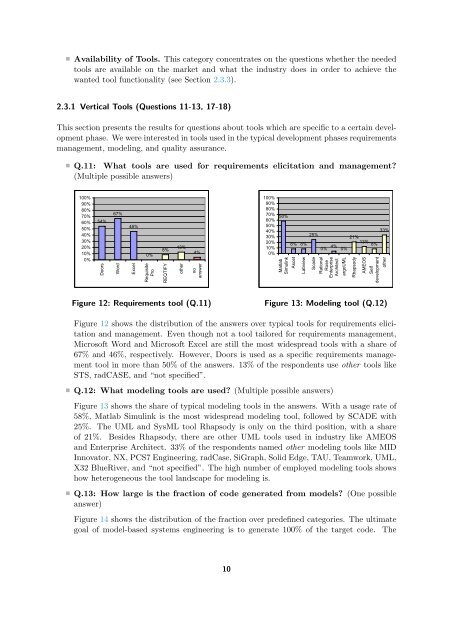SPES 2020 Deliverable 1.4.B-1 Result of the Tool Questionnaire
SPES 2020 Deliverable 1.4.B-1 Result of the Tool Questionnaire
SPES 2020 Deliverable 1.4.B-1 Result of the Tool Questionnaire
You also want an ePaper? Increase the reach of your titles
YUMPU automatically turns print PDFs into web optimized ePapers that Google loves.
Availability <strong>of</strong> <strong>Tool</strong>s. This category concentrates on <strong>the</strong> questions whe<strong>the</strong>r <strong>the</strong> needed<br />
tools are available on <strong>the</strong> market and what <strong>the</strong> industry does in order to achieve <strong>the</strong><br />
wanted tool functionality (see Section 2.3.3).<br />
2.3.1 Vertical <strong>Tool</strong>s (Questions 11-13, 17-18)<br />
This section presents <strong>the</strong> results for questions about tools which are specific to a certain development<br />
phase. We were interested in tools used in <strong>the</strong> typical development phases requirements<br />
management, modeling, and quality assurance.<br />
Q.11: What tools are used for requirements elicitation and management?<br />
(Multiple possible answers)<br />
100%<br />
90%<br />
80%<br />
70%<br />
60%<br />
50%<br />
40%<br />
30%<br />
20%<br />
10%<br />
0%<br />
54%<br />
Doors<br />
67%<br />
Word<br />
46%<br />
Excel<br />
0%<br />
Requisite<br />
Pro<br />
8%<br />
REQTIFY<br />
13%<br />
o<strong>the</strong>r<br />
4%<br />
no<br />
answer<br />
Figure 12: Requirements tool (Q.11)<br />
100%<br />
90%<br />
80%<br />
70%<br />
60%<br />
50%<br />
40%<br />
30%<br />
20%<br />
10%<br />
0%<br />
58%<br />
Matlab<br />
Simulink<br />
Ascet<br />
8% 8%<br />
Labview<br />
25%<br />
0% 4% 0%<br />
Scade<br />
Rational<br />
Rose<br />
Enterprise<br />
Architect<br />
argoUML<br />
21%<br />
13% 8%<br />
Rhapsody<br />
33%<br />
AMEOS<br />
Self<br />
development<br />
o<strong>the</strong>r<br />
Figure 13: Modeling tool (Q.12)<br />
Figure 12 shows <strong>the</strong> distribution <strong>of</strong> <strong>the</strong> answers over typical tools for requirements elicitation<br />
and management. Even though not a tool tailored for requirements management,<br />
Micros<strong>of</strong>t Word and Micros<strong>of</strong>t Excel are still <strong>the</strong> most widespread tools with a share <strong>of</strong><br />
67% and 46%, respectively. However, Doors is used as a specific requirements management<br />
tool in more than 50% <strong>of</strong> <strong>the</strong> answers. 13% <strong>of</strong> <strong>the</strong> respondents use o<strong>the</strong>r tools like<br />
STS, radCASE, and “not specified”.<br />
Q.12: What modeling tools are used? (Multiple possible answers)<br />
Figure 13 shows <strong>the</strong> share <strong>of</strong> typical modeling tools in <strong>the</strong> answers. With a usage rate <strong>of</strong><br />
58%, Matlab Simulink is <strong>the</strong> most widespread modeling tool, followed by SCADE with<br />
25%. The UML and SysML tool Rhapsody is only on <strong>the</strong> third position, with a share<br />
<strong>of</strong> 21%. Besides Rhapsody, <strong>the</strong>re are o<strong>the</strong>r UML tools used in industry like AMEOS<br />
and Enterprise Architect. 33% <strong>of</strong> <strong>the</strong> respondents named o<strong>the</strong>r modeling tools like MID<br />
Innovator, NX, PCS7 Engineering, radCase, SiGraph, Solid Edge, TAU, Teamwork, UML,<br />
X32 BlueRiver, and “not specified”. The high number <strong>of</strong> employed modeling tools shows<br />
how heterogeneous <strong>the</strong> tool landscape for modeling is.<br />
Q.13: How large is <strong>the</strong> fraction <strong>of</strong> code generated from models? (One possible<br />
answer)<br />
Figure 14 shows <strong>the</strong> distribution <strong>of</strong> <strong>the</strong> fraction over predefined categories. The ultimate<br />
goal <strong>of</strong> model-based systems engineering is to generate 100% <strong>of</strong> <strong>the</strong> target code. The<br />
10
















